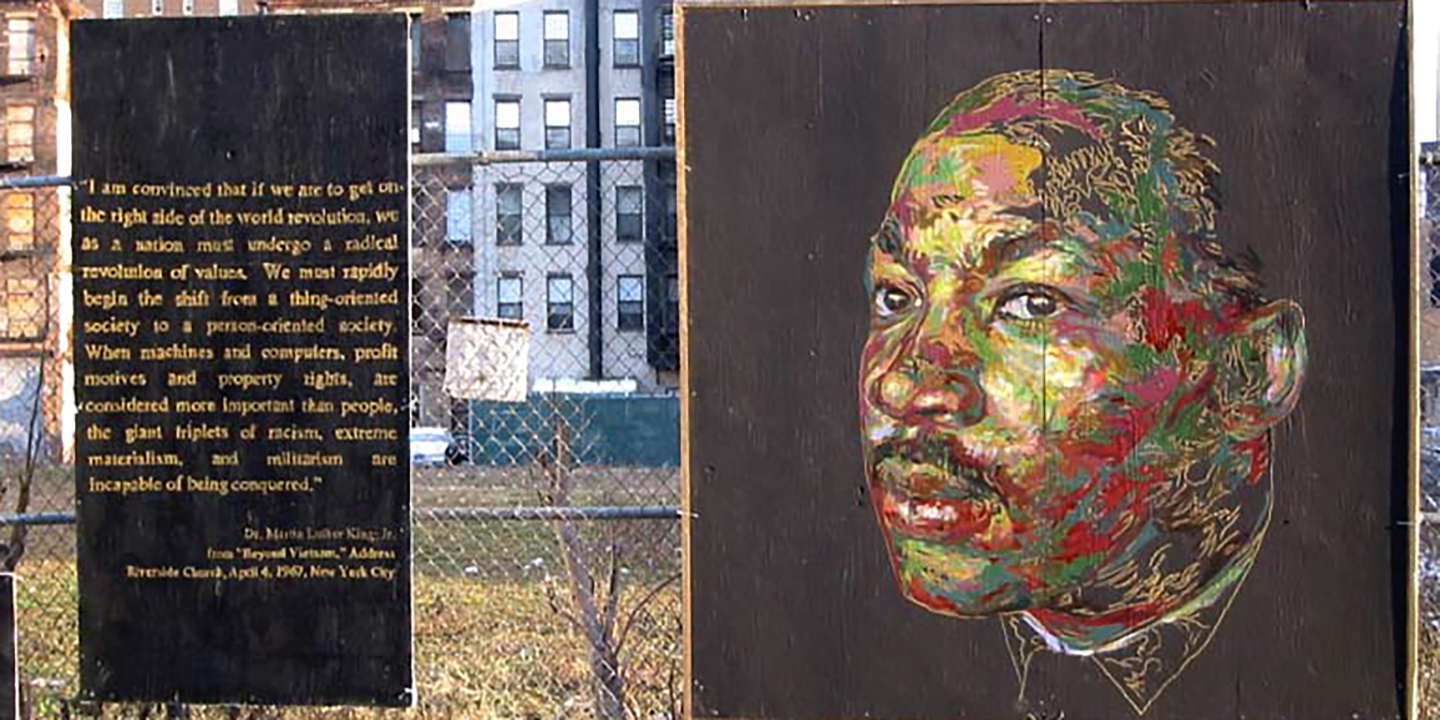
Martin Luther King Jr. – AHIMSA
January 2003 | 127th Street and 8th Avenue, Harlem, New York
Centering ahimsa and nonviolence in Martin Luther King Jr.’s legacy
BACKGROUND
African American human rights legend Martin Luther King Jr. was born on January 15th. In January 2003, thirty-four years after his assassination, we found ourselves in a world indifferent to the lessons of his life and the invaluable wisdom of his words. The general ignorance to Martin Luther King Jr.’s experiences and philosophies grew with each year since his passing, and he became more and more an icon of emptiness. Several years of naming busy streets in Black neighborhoods and creating a holiday that the corporate realm largely ignored left a world disconnected from the transcendent contributions of the greatest “drum major for peace.”
On Dr. King’s birthday, January 15, 2003, the George W. Bush administration urged the Supreme Court to block the University of Michigan, and universities in general, from taking race into account when making admissions decisions. The United States government’s interest in dismantling affirmative action programs was an attempt to neutralize Martin Luther King Jr.’s efforts to close the educational, social, and economic gaps between Black and white Americans that continue to this day.
On January 16, 2003, the Federal Communications Commission (FCC) was part of a public hearing at Columbia University to talk about media deregulation as radio broadcasting, television, and newspaper companies were increasingly owned and controlled by the few. The shrinking democratic voice that came with media conglomeration was antithetical to the inclusive voices Martin Luther King Jr. brought together through the Southern Christian Leadership Conference (SCLC) and elsewhere. People committed to Dr. King’s multifaith, multi-ethnic, multi-class alliances marched arm-in-arm and committed civil disobedience together, filled jails together, and stood up to bombings, beatings, jailing, and assassination plots together to lead the struggle for civil rights.
In January 2003, the most transcendent of Dr. King’s value systems was the one most blatantly forgotten and ignored. As warfare became mainstream and violence active worldwide, the idea of ahimsa (nonviolence) was forgotten. It was a sad irony that the philosophy that was Martin Luther King Jr.’s foundation was the value recognized least–and needed the most.
Ahimsa is discussed in Pantanjali’s Yoga Sutras, an ancient Indian text delineating the philosophical underpinnings of righteous living. Mahatma Gandhi based his own human rights work on ahimsa, and Martin Luther King Jr. studied and adapted Gandhi’s inspiration for his own struggles. Dr. King said: “Nonviolence means avoiding not only external physical violence but also internal violence of spirit. You not only refuse to shoot a man, but you refuse to hate him.”
PROJECT DESCRIPTION
Martin Luther King Jr. – AHIMSA was a project to educate participants about Martin Luther King Jr.’s life and inspire everyone to be better. Images of Dr. King wrongfully arrested and manhandled, struck on the right temple with a rock, stabbed with a seven-inch letter opener in the chest, and lying on the hotel balcony after being shot were juxtaposed next to quotations he made against racism, materialism, militarism, and violence. The juxtaposition of these violent episodes with his words of peace evidenced the extraordinary commitment Dr. King had to nonviolence, providing an impetus to all who continue to live in contemporary times of violence.
In spite of a global movement towards war, this project was an effort to highlight philosophies that magnified peace. In spite of media control that restricted what information could be transmitted, this project was an action to expand the consciousness of the mainstream. And in spite of the trivialization of Martin Luther King Jr.’s birthday in America, this project immortalized an African American who was a hero for all humanity.
“I am convinced that if we are to get on the right side of the world revolution, we as a nation must undergo a radical revolution of values. We must rapidly begin the shift from a thing-oriented society to a person-oriented society. When machines and computers, profit motives and property rights, are considered more important than people, the giant triplets of racism, extreme materialism, and militarism are incapable of being conquered.”
— Dr. Martin Luther King Jr., “Beyond Vietnam,” Riverside Church, New York, New York, April 4, 1967
“The ultimate weakness of violence is that it is a descending spiral, begetting the very thing it seeks to destroy. Instead of diminishing evil, it multiplies it. Through violence you may murder the liar, but you cannot murder the lie, nor establish the truth. Through violence you may murder the hater, but you do not murder hate. In fact, violence merely increases hate. So it goes. Returning violence for violence multiplies violence, adding deeper darkness to a night already devoid of stars. Darkness cannot drive out darkness: only light can do that. Hate cannot drive out hate: only love can do that.”
— Dr. Martin Luther King Jr., “Where Do We Go From Here?,” delivered at the Eleventh Annual SCLC Convention, August 16, 1967
“I want you to say that I tried to love and serve humanity…say that I was a drum major for justice; say that I was a drum major for peace; I was a drum major for righteousness…I just want to leave a committed life behind.”
— Dr. Martin Luther King Jr., “The Drum Major Instinct,” delivered at Ebenezer Baptist Church, Atlanta, Georgia, February 4, 1968
Video by Frank Parga